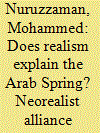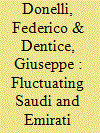| Srl | Item |
| 1 |
ID:
179857


|
|
|
|
|
| Summary/Abstract |
Dominant International Relations theories—realism/neorealism, liberalism/neoliberalism, and constructivism—have so far developed no rigorous theoretical attempts to interpret the Arab Spring, though some marginal efforts have been made to critique the failure of realism to interpret this historical development. This article presents a neorealist interpretation of the Arab Spring focusing on the Syrian civil war, where conflicts between the pro- and anti-status quo forces have unfolded in alignments and counter-alignments centering around rival domestic and external groups. To explain the involvements of rival alliances in the post-2011 Syrian conflict, namely, the United States–Saudi Arabia–Israel alliance and the Russia–Iran–Syria alliance, this analysis employs neorealist theories of alliance formation—the balance of power and balance of threat theories—as articulated by Kenneth Waltz and Stephen Walt, respectively. The dynamics of these formations in Syria lend more support to Walt’s theory that states balance against threats rather than against power. The complex nature and dynamics of the Syrian war, however, calls for refinements of Walt’s balance of threat theory. Accordingly, the article also explores various refinements of Walt’s theory to better explain future complex civil wars involving highly polarized domestic and external parties.
|
|
|
|
|
|
|
|
|
|
|
|
|
|
|
|
| 2 |
ID:
172388


|
|
|
|
|
| Summary/Abstract |
The overthrow of Omar al-Bashir after three decades of rule has brought to light a dynamic that has been present for years: an interweaving of political, economic and security issues between the states of the Horn of Africa and the Gulf monarchies. Since 2011, the most active powers are the Kingdom of Saudi Arabia and the United Arab Emirates, which seek political support to counter both Iran’s influence and the growing Turkish presence. The two Gulf monarchies’ search for alignments with African counterparts has favoured the continuous reshuffling of alliances with direct effects on the local actors’ strategic choices. These dynamics need to be considered to understand the determinants behind the currently increasing instability in the Red Sea area.
|
|
|
|
|
|
|
|
|
|
|
|
|
|
|
|